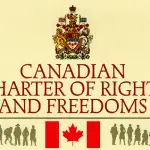
Because of its dualist colonial history, Canada has an unusual legal system. Its parliaments are based on Westminster structures and conventions, and they use a similar legislative process to that of Britain and Australia. Much of Canada also uses British common law principles. Canada has its own court hierarchy, its courts serve as both original and appellate courts, and they employ the doctrine of precedent. The province of Quebec, which has a majority French-speaking population, uses a hybrid legal system. In Quebec, criminal law is based upon common law while civil disputes are resolved using a system derived from the French legal code.
Canada did not have a single constitutional document until 1982 when it was decided to codify various fundamental laws and conventions into one act. The Constitution Act was passed, consolidating and amending a number of previous British and Canadian acts, such as the British North America Act (1867). The new act also entrenched itself as the ‘supreme’ law, authorising courts to invalidate laws which they found incompatible with the act. The process for amending the Constitution Act is a complex one. There are five types of amendments, depending on which part of the Constitution Act is being changed. Some parts can be changed by provincial or Federal parliaments alone; others require the support of the Federal parliament and two-thirds of the provincial parliaments; others require unanimous support.
Canada has had a bill of rights since 1960, however, it was simply an act of the Federal Parliament, not an entrenched set of rights. In 1982 it was replaced by the Canadian Charter of Rights and Freedoms, which forms Part I of the Constitution Act. Rights are categories into six groups:
- Fundamental freedoms, such as conscience, religion, thought, belief, expression, association and assembly.
- Democratic rights, such as the right to vote in regular elections.
- Mobility rights, such as the right to enter or leave Canada, and to move around, live and work in any of its provinces.
- Legal rights, such as the right to life and liberty, natural justice and due process, and freedom from unfair arrest, search or detention.
- Equality rights, determining that all citizens are equal before the law and are not to be the subject of discrimination.
- Language rights, allowing English, French and Native Canadian speakers to be educated in and use the language of their heritage.
The enforcement of Canada’s Charter of Rights and Freedoms is similar to other nations. All Canadian parliaments and their attorney-generals must review new bills in light of the rights expressed in the charter. The charter is unusual in that it contains a limitation clause, allowing any Canadian government to suspend these rights and freedoms (except for democratic and mobility rights, which cannot be overridden in any case) for up to five years. This power was included as an emergency measure during times of war or internal strife. To date it has never been used by the Federal government, however, it has been used twice by provincial governments (once to end a strike, another to legislate a strictly heterosexual definition of marriage).
Once legislation is enacted, citizens can challenge it in the courts if they believe it breaches their rights. The courts can declare an act to be in breach of one or more constitutional rights, and therefore invalid. In making these rulings the courts may also provide other penalties to the complainant, such as an award of damages or restitution. The Supreme Court of Canada, the nation’s highest court, can also advise the government about the validity of proposed bills. This formal involvement of a court during the legislative process is unusual but effective, though critics say it subverts the separation of powers.
© lawgovpol.com 2014. Content on this page may not be republished or distributed without permission. For more information please refer to our Terms of Use.
